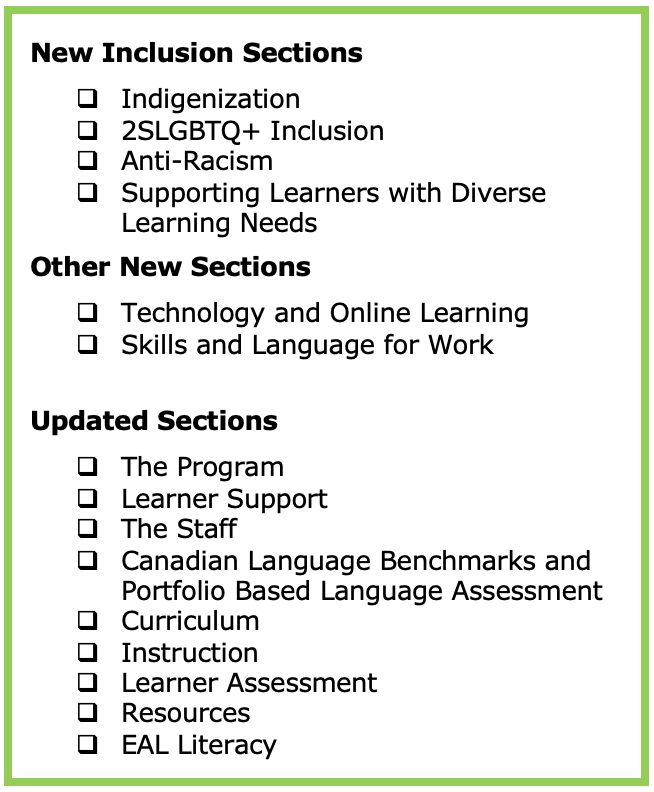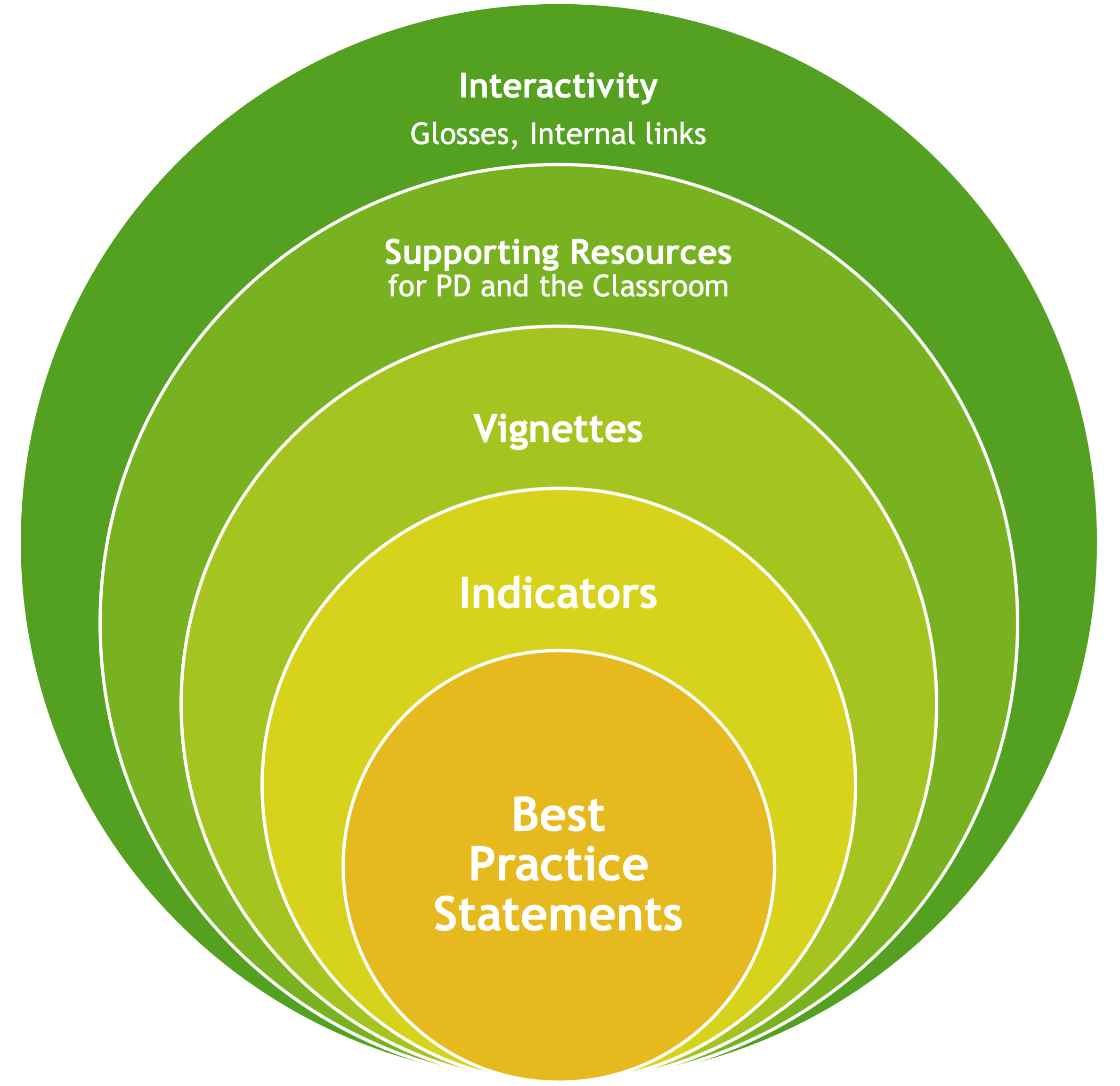Introduction to the ATESL Best Practices
A Brief History
The Alberta Teachers of English as a Second Language (ATESL) Best Practice Guidelines for Adult ESL/LINC Programming in Alberta was originally drafted in 1994 in response to the federal government’s implementation of Language Instruction for Newcomers to Canada (LINC). The document was one of the first of its kind to specify a list of quality practices related to EAL programming. Since that time, standards documents focusing on the provision of English language instruction to adult learners have emerged in other jurisdictions and countries, including the following:
- TESOL Standards for Adult Education ESL Programs (TESOL, 2003)
- Guidelines for English as a Second Language (ESL) Programming and Services (Nova Scotia Department of Education, 2003)
- TESOL Technology Standards Framework (TESOL, 2008)
- Standards and Criteria for ELT Centres (NEAS Australia, 2008)
- Keystone Concepts: Guiding Principles and Components of Program Planning (Toronto Catholic District School Board, 2015)
- NEAS Australia Quality Practice Guide (NEAS Quality Assurance in Education and Training, 2019)
- A Principles-based Approach to Supporting Learners (AMSSA, Strengthening Diversity in BC; Solnes, Yuen, & Wilber, 2019)
The ATESL Best Practices document was revised in 2004[1], and then underwent a significant re-write in 2009[2]. The 2009 revision led to the creation of 67 statements of best practice for adult ESL/LINC programs in Alberta, each supported by indicators that demonstrate and clarify the best practice. These statements were organized into nine sections: The Program, Learner Support, Staff, CLB (Canadian Language Benchmarks), Curriculum, Instruction, Learner Assessment, Resources, and ESL literacy.
While most of the best practice statements and their clarifying indicators remain relevant, there have been multiple shifts in practice and priorities related to EAL instruction in Canada over the last decade, including new practices and guiding documents related to EAL literacy, Portfolio Based Language Instruction (PBLA), and Skills for Success (Essential Skills). Also, advances in technology for learning, accelerated by the Covid-19 pandemic and the subsequent switch to online teaching by most EAL instructors in the province, have changed how learners access learning and how instructors provide learning. Most crucially, there is growing recognition of the need in our profession to very deliberately address the inclusion and needs of marginalized groups of learners: 2SLGBTQ+ learners, learners with disabilities, learners managing issues related to trauma, and racialized learners. Related to this, there is the need for our profession to respond effectively and thoughtfully to the multiple calls for reconciliation, justice and equity that we have seen over the last decade, most especially in relationship with the Indigenous peoples in Canada.
Our language learners both strive and deserve to have their voices heard, their learning needs met, their rights acknowledged, and their identity respected both within and beyond the confines of adult EAL learning structures – a mandate that this third revision of ATESL’s Best Practices for Adult EAL and LINC Programming in Alberta aims to address.
A Shift in Terminology
The term “ESL” (English as a Second Language), used in the previous documents, has been replaced with “EAL” (English as Additional Language) in this document. This more inclusive term recognizes that learners of English may speak many more than just two languages.
The Process of Revision
A project team was hired with the mandate to update the 2009 Best Practices document to reflect the changes in priorities and practices in the EAL profession over the past decade, and specifically to address inclusion, update technology, and ensure that the best practices would be accessible and useful even in non-traditional contexts. The project began with an initial literature review of existing best practice documents, LGBTQ inclusion, Indigenization, and learning disabilities. (See Literature Review)
The project team then surveyed ATESL members to explore their familiarity with and use of the 2009 Best Practices document, as well as to gather information about barriers and practices related to inclusion, Indigenization, and technology in EAL instruction in Alberta. ATESL members were also asked for input on how to improve the accessibility and usability of the document/website. Feedback from the survey informed the content of the inclusion and technology sections. As well, it guided subsequent decisions related to the format and interactivity of the best practices website.

Inclusion Advisors were hired to provide expertise, input and guidance into the drafting of new best practice sections related to LGBTQ2S+ inclusion, Indigenization, and supporting learners with a variety of learning needs. Subsequently, additional sections were drafted related to Anti-Racism, Technology and Online Learning, and Skills and Language for work. The EAL for Literacy section was also significantly updated, along with the Instruction section. Each of these sections include Best practice statements and indicators, similar in format to the 2009 document. They also include vignettes that illustrate how the best practices may be applied in a variety of contexts, along with a curated collection of professional development resources, classroom resources, and community resources.
The new sections were sent for review to selected ATESL members and others with expertise in those areas. These reviewers provided input on the best practices, suggested additional resources, and in some instances assisted with the composition of some of the vignettes.
The remaining best practice sections were then updated, and professional development resources and classroom resources (where relevant) were again curated for each section.
Once the document was drafted, ATESL members and Community Adult Learning Program (CALP) members were invited to provide additional input on the best practices during focus group consultations. A total of 54 participants attended the online focus group sessions. These focus group discussions affirmed the content of the best practices and resulted in further enrichment and polishing of the document.
A web-portal was then designed that allows for interactivity, glosses, and easy access to resources that support the best practices – all characteristics that were requested in the survey and the focus groups.
An Aspirational Document

Best Practices for Adult EAL and LINC Programming in Alberta is organized into the 15 sections described above. The core of each section are the Statements of Best Practice, each supported by lists of Indicators that identify ways to meet the best practice. To encourage implementation of the best practices in both traditional and non-traditional classrooms, Vignettes illustrate how the best practices may be applied in a variety of contexts. Also, each section comes with a curated list of Supporting Resources for professional development, as well as resources for the classroom (where relevant). Glosses, internal links, and links to resources enhance the usability of the document. To ensure accessibility, the ATESL Best Practices are available in a variety of formats:
- Website: The version on the website includes glosses, descriptions of and links to resources, PDFs of the best practice chapters, and checklist versions of the best practices.
https://www.atesl.ca/resources/best-practices-adult-eal-and-linc-programming-alberta/ - PressBook: The PressBook version includes glosses, internal links, and links to resources.
- PDF and EPUB 2.01 (available on the website)
The ATESL Best Practice document delineates a common set of expectations regarding what constitutes best practice in adult EAL and LINC programming in Alberta. However, as in the 2009 document, it is important to note that this is not a prescriptive document. It is not expected that all programs or individuals will be able to “check off” all of the indicators under a statement of best practice. Instead, the best practices should be viewed as aspirational. The indicators are there to clarify and identify ways to meet the expectations set up by the best practice statements. With the ATESL Best Practices, we aim to do the following:
- Provide a frame of reference for all those involved in providing EAL programming in Alberta.
- Guide EAL practitioners as they reflect on their roles as instructors, administrators, facilitators, and volunteers.
- Provide goals to aspire to (the Statements of Best Practice) along with concrete steps to take to reach those goals (the bulleted Indicators)
- Prompt the desire to learn and explore more about the practices being described (the References and PD Resources sections).
- Connect instructors with easy to access resources they can use in their classrooms (the Resources for the Classroom and Community Resources sections).
Most importantly, this third revision of ATESL’s Best Practice Guidelines for Adult EAL and LINC Programming in Alberta aims to guide and support EAL instructors and programs as they ensure that their language learners’ voices are heard, their learning needs met, their rights acknowledged, and their identity respected both within their classes and in the broader Canadian community.
References
Gnida, S., & Light, J. (2009). ATESL Best Practices for Adult ESL and LINC Programming in Alberta. Government of Alberta and Citizenship and Immigration Canada.
NEAS Australia. (2008). Standards and Criteria for ELT Centres. North Sydney, Australia
NEAS Quality Assurance in Education and Training. (2019). NEAS Australia Quality Practice Guide.
https://neas.org.au/wp-content/uploads/2019/09/Quality-Practice-Guide_2019-002.pdf
Nova Scotia Department of Education. (2003). Guidelines for English as a Second Language (ESL) Programming and Services. Province of Nova Scotia. https://studentservices.ednet.ns.ca/sites/default/files/esl_guidelines_web.pdf
Solnes, A., Yuen, S. and Wilbur, A. (2019). A Principles-Based Approach to Supporting LINC Learners. AMSSA, Strengthening Diversity in BC. Retrieved from https://www.amssa.org/wp-content/uploads/2019/04/A-Principles-based-Approach-to-Supporting-LINC-Learners-April-2019.pdf
Teachers of English to Speakers of Other Languages. (2003). Standards for Adult Education ESL Programs, Standards 1 & 4.
Teachers of English to Speakers of Other Languages (TESOL). (2008). TESOL Technology Standards Framework.
https://www.tesol.org/docs/default-source/books/bk_technologystandards_framework_721.pdf?sfvrsn=4bd0bee6_2
Toronto Catholic District School Board. (2015). Keystone Concepts: Guiding Principles and Components of Program Planning. Retrieved from https://www.quartzon.ca/documents/keystoneConcepts-Nov27.pdf

